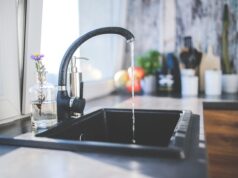Contents
Freezing Faucets: Troubleshooting the Lack of Hot Water in Your Kitchen Sink
If you’re experiencing a frustrating lack of hot water in your kitchen sink, it could be an issue related to freezing faucets. In cold climates, freezing temperatures can prevent hot water from flowing properly, resulting in an inconvenience for daily kitchen tasks.
Causes of Freezing Faucets: Freezing faucets can occur due to various reasons, such as inadequate insulation, exposed pipes, or even a malfunctioning hot water heater. Identifying the root cause is crucial in resolving this issue effectively.
Troubleshooting the Lack of Hot Water: To troubleshoot the lack of hot water in your kitchen sink, you first need to inspect the faucet and pipes. Look for any visible signs of freezing, such as frost or ice accumulation. If you notice freezing, it’s important to take immediate action to prevent further damage.
Preventive Measures: To prevent freezing faucets in the future, consider insulating your pipes, especially in areas prone to extreme cold. Adding pipe insulation or heat tape can help maintain the temperature and keep the water flowing smoothly.
If the issue persists or you need professional assistance, it’s advisable to contact a licensed plumber who can diagnose the problem accurately and offer the most suitable solution.
By understanding and troubleshooting freezing faucets, you can ensure a consistent supply of hot water in your kitchen sink, even in the coldest of climates.
Freezing Faucets: Troubleshooting the Lack of Hot Water in Your Kitchen Sink
Identifying the Problem
If you’ve been experiencing a lack of hot water in your kitchen sink, it can be frustrating and inconvenient. Before you panic, it’s important to troubleshoot and identify the issue at hand. Here are some common causes and solutions to help you fix the problem.
1. Check the Water Heater
The first thing you should do is check your water heater. Ensure that it is turned on and functioning properly. If the pilot light is out, relight it according to the manufacturer’s instructions. Sometimes the temperature on the water heater may also need adjustment.
2. Inspect the Faucet
Next, take a closer look at your kitchen faucet. If it’s a single-handle faucet, the cartridge or valve may be malfunctioning. You can try cleaning or replacing it. For a double-handle faucet, check both hot and cold water supplies. If the hot water supply valve is closed or partially blocked, it can cause the lack of hot water.
3. Examine the Pipes
Check the pipes connected to your kitchen sink. Cold weather can sometimes cause freezing, leading to a lack of hot water flow. Insulate the pipes with foam pipe insulation or use heat tape to prevent freezing. Additionally, check for any leaks or damaged pipes that may be affecting the hot water supply.
4. Test the Pressure
Low water pressure can also contribute to the lack of hot water. Remove and clean the aerator on your faucet, as debris can accumulate and restrict the flow. If the problem persists, you might need to consult a professional plumber to assess and fix any underlying issues.
Conclusion
Having a freezing faucet in your kitchen sink can be a hassle, but by troubleshooting and identifying the problem, you can take the necessary steps to restore hot water flow. Remember to check your water heater, inspect the faucet, examine the pipes, and test the pressure for a comprehensive approach to resolving this issue.
For more information and tips on plumbing troubleshooting, visit Plumbing.com
Frequently Asked Questions – Freezing Faucets
Q1: What should I do if there’s no hot water in my kitchen sink?
There can be multiple reasons why you may not have hot water in your kitchen sink. Here are a few troubleshooting steps:
- Check if the hot water valve under the sink is fully open.
- Verify that the hot water supply line to the faucet is not frozen or blocked.
- Inspect the water heater to ensure it is functioning properly.
- If you have a single-handle faucet, make sure the handle is positioned correctly to allow hot water flow.
- If none of these steps help, it’s recommended to seek professional plumbing assistance.
Q2: How can I prevent my kitchen sink faucet from freezing?
To prevent your kitchen sink faucet from freezing, you can take the following precautions:
- Provide insulation to exposed pipes and water lines located in areas prone to freezing, such as exterior walls or unheated spaces.
- Keep cabinet doors beneath the sink open during extremely cold weather to allow warm air to circulate around the pipes.
- Drip water from both hot and cold faucets during freezing temperatures to prevent water from freezing.
- Consider installing heat tape or pipe insulation to keep the pipes warm.
Q3: What should I do if my kitchen sink faucet freezes?
If your kitchen sink faucet has frozen, here are a few steps to consider:
- Turn off the water supply to the faucet.
- Thaw the frozen pipe gently using a hairdryer, space heater, or heat tape.
- Do not use any open flames or high-heat devices to thaw the pipe as it can damage the plumbing system.
- Once the pipe is thawed, turn on the faucet and check for any leaks.
- If you are uncertain or unable to thaw the pipe yourself, contact a professional plumber.
No Hot Water in Kitchen Sink – What to Do?
Possible Causes
When you find yourself facing the frustrating issue of having no hot water in your kitchen sink, there could be several reasons behind it. Let’s explore some possible causes:
- A faulty water heater
- A malfunctioning mixing valve
- A clog in the hot water pipe
- A problem with the faucet’s cartridge or valve
Steps to Troubleshoot
If you’re experiencing this problem, follow these steps to troubleshoot the issue:
- Check the water heater: Ensure that the gas valve or electrical circuit to the water heater is functioning correctly. Make sure the temperature setting is adequate and the pilot light (if applicable) is lit.
- Inspect the mixing valve: The mixing valve, also known as the tempering valve, could be stuck or malfunctioning. Consider consulting a professional plumber for assistance if needed.
- Clear any clogs: If there’s a clog in the hot water pipe leading to your kitchen sink, it may be restricting the flow of hot water. Use appropriate tools or seek professional help to remove any blockages.
- Check the faucet: Examine the faucet’s cartridge or valve. It could be worn out or faulty, preventing hot water from flowing. Consider replacing it with a new one.
Remember, if you’re not confident in your plumbing skills, it’s always advisable to consult a professional to avoid causing further damage.
Further Information
For more comprehensive information on plumbing issues, you can visit the Plumbing page on Wikipedia.
Freezing Faucets: Troubleshooting the Lack of Hot Water in Your Kitchen Sink
Common Causes:
- Insufficient insulation
- Frozen pipes or water lines
- Malfunctioning thermostat
Steps to Troubleshoot:
- Check if other faucets have hot water
- Inspect the insulation around the pipes
- Thaw any frozen pipes or water lines
- Reset or replace the thermostat if necessary
Preventive Measures:
- Ensure proper insulation around pipes
- Keep cabinet doors open to allow heat circulation
- Let water drip during extremely cold weather
- Regularly maintain and repair your hot water system


































